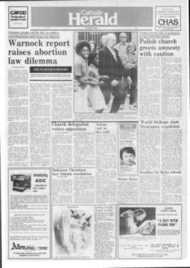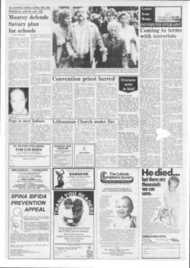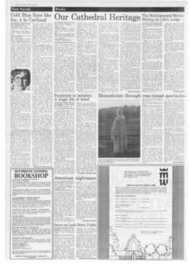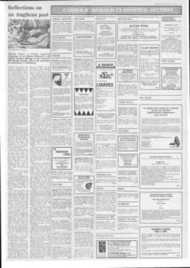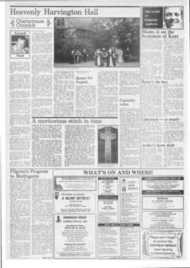Page 7, 27th July 1984
Page 7
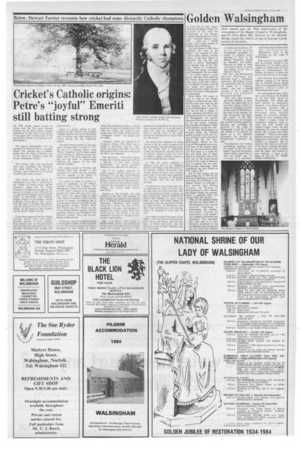
Report an error
Noticed an error on this page?If you've noticed an error in this article please click here to report it.
Tags
Share
Related articles
Ejuvenation For Chapel Shrine
Mgr. Parker Ends Shrine Rivalry
Walsingham Still The Nation's Favourite Place Of Pilgrimage
`isle' Of Norfolk Is Proudly Independent
In The Footsteps Of The Faithful
Golden Walsingham
Next month sees the 50th anniversary of the restoration of the Slipper Chapel at Walsingham, and Fr Clive Birch SM, Director of the Norfolk Shrine, traces the rebirth of one of Europe's great centres of devotion.
IT WAS ON the 19th August 1934 that the Slipper Chapel was restored to use and was established as the Roman Catholic National Shrine of Our Lady. Cardinal Bourne came with some say 20,000 people, and a good number of bishops and archbishops.
The story begins in 1061 when Richeldis, the Lady of the Manor, was inspired by Our Lady to build a Shrine, a simple replica of the Holy House of Nazareth. This she did, and within a century Walsingham had become one of the four great Shrines of Christianity, ranking with Rome, Jerusalem and Compostella. By the middle of the twelfth century a great priory had been built enclosing the Shrine. Kings and paupers alike came to pay their respects to the Mother of God; in fact all the Kings and Queens of England between Henry III and Henry V111 came to Walsingham on pilgrimage.
When Henry came, he used to stop at the Slipper Chapel to confess his sins, take off his shoes and walk the last mile barefoot into the 'Holy Land of Walsingham'. After his last visit he had a change of heart, destroyed the Shrine and outlawed devotion to Our Lady of Walsingham; but secretly devotion lived on and at the end of the last century Charlotte Boyd bought the Slipper Chapel and restored it at her own cost.
At this time, Walsingham was situated within the Catholic parish of King's Lynn and so it was in King's Lynn in the parish church that the first postReformation Shrine to Our Lady of Walsingham was set up. The form of the original statue was not yet known and so Pope Leo XIII chose as a model for the new statue that of Santa Maria in Cosmedin. One of the first acts of the newly-formed Guild of Our Lady of Ransom was to organise the first postReformation pilgrimage which established the new Shrine on 19th August 1897.
And so 19th August was the appropriate day in 1934 for the National Pilgrimage to mark the restoration of the Shrine to the Slipper Chapel. In reflection a few months later Bishop Youens, the Bishop of Northampton in whose diocese the Slipper Chapel was situated, wrote a pastoral letter for Advent 1934. He said this: "One of the greatest events that has ever taken place, in this England of ours, was the National Pilgrimage to Walsingham last summer. (Successful beyond all expectations, it was indeed a very triumph of devotion and splendour). The thousands who took part in it were obviously overjoyed to see our Blessed Lady coming into her own. After four centuries of gloom and desolation, the lovely lanes around Walsingham re-echoed the sound of pilgrim voices chanting to Jesus in the Blessed Sacrament, hymns of adoration and praise, followed by many of those well-known hymns in praise and honour of her who is Heaven's Queen".
This first post-Reformation National Pilgrimage had obviously made a tremendous impression. But Bishop Youens was determined that this should not simply be a "one-day wonder" and that it should continue to be a centre of devotion for Catholics throughout the land: "And now, dear brethren and dear children in Jesus Christ, our plain duty is to use every means within our power of spreading devotion to Our Lady of Walsingham, not only in this diocese, but also throughout the length and breath of the land. The Bishop goes on to suggest that another excellent means of fostering and spreading the devotion to Our Lady of Walsingham would be to raise new shrines in her honour. he quotes as a very beautiful example the pulpit in Westminster Cathedral. He says:
"His Eminence the Cardinal Archbishop, speaking from the pulpit for the first time, made it clear that the primary motive which urged him to erect the pulpit was the nrnviding of a permanent
and lasting thank offering for the restoration at Walsingham itself of the devotion to Our Lady of Walsingham."
That was fifty years ago. 1984 sees the Golden Jubilee of the Restoration of the Shrine and a number of celebrations will take place to commemorate this Jubilee, the details of which are given at the bottom of this page.
Each year sees more and more pilgrims corning to the Shrine and the English Tourist Board tells us that something like half a million visitors come to Walsingham each year.
For nine hundred years, (since Our Lady inspired the building of the first Holy House in Walsingham), this village has been known as England's Nazareth. It has been a place of pilgrimage, penance and a source of blessings and miraculous cures, spiritual healing for countless millions. During the four hundred years of silence a steady trickle of courageous pilgrims used to come and pray outside the Slipper Chapel, today the only remaining link with the original Shrine. (But prayers have been answered) Mary is once again publicly honoured in her chosen village and continually calls her children to penance and to excercise their faith in and love of her Son by making the effort to come here and pray in union with the saints and sinners of past centuries. 1 hope to see many of you at our Golden Jubilee Celebrations.
blog comments powered by Disqus


